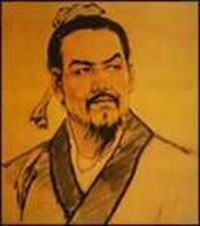LESSON 2.2 - CHINA
Confucius, Han Feizi, Laozi & Siddhartha
Imagine how you would feel if the mayor of Ashcroft was continuously waging a war on the mayor of Cache Creek and Spence's Bridge.
Eventually, you may start wondering how it might be to live in harmony.
During the Warring States period in China, four individuals sought out answers to the question: HOW CAN WE LIVE IN HARMONY? The four individuals were: Confucius, Han Feizi, Laozi, and Siddhartha.
HARMONY - is a pleasing combination of elements in a whole.
PHILOSOPHER - One who studies the fundamental nature of knowledge, reality, and existence, especially when considered as an academic discipline.
What does a Philosopher look like??
Confucius
 -Lived from 551 - 479 BCE
-Lived from 551 - 479 BCE-The system of ethics, education, and statesmanship taught by Confucius and his followers.
-Taught respect for tradition and duty
-He believed that chaos in Society was caused by bad behaviours in government and people not leading virtuous lives.
-He believed that people were basically good, but needed to be trained to behave well.
-people could build a Harmonious society by striving for 5 virtues:
1. Hones
2. Upright
3. Conscientious
4. Charitable
5. Loving in all Relationships
 Han Feizi
Han Feizi-Lived from 280 - 233 BCE
-He was a leading writer for a group of philosphers called the LEGALISTS.
-He believed all people were basically selfish and greedy.
-They believed that rulers had to be strong and ruthless through strict laws and harsh punishments.
 Laozi
Laozi-Lived during the 6th century BCE
-Daoism is based on the teachings of the philosopher Laozi.
-They believe that by studying nature closely you would be able to live in harmony with it.
-They believed that disturbing nature harms the well-being of humans.
-Daoist's were opposed to rules and customs because they believed that this stopped people from behaving naturally.
 Siddhartha
Siddhartha-Lived around 563 BCE
-Buddhism developed from the teachings of an Indian prince called Siddhartha.
-He believed he received enlightenment an became Buddha.
-Buddha believed that suffering occurred because people were too concerned with themselves and their own desires and needs.
-Buddha taught that people should seek to free themselves of worldly concerns through meditation.
-Buddhists also believe in reincarnation - the idea that a soul is reborn again and again until it finds enlightenment.
VOCABULARY
Moral - abiding by a set of rules about right and wrong conduct.
Ethical - making right choices.
Exile - being forced to live far away from one's community, or country.
Treason - betrayal of one's country or ruler.
Alchemist - an early chemist whose methods would now be considered scientifically unsound.
Immortality - endless life.
Mercury - a silver-white metal that is liquid at room temperature.
Metallurgy - the science of producing and purifying metals.
Enlightenment - being awake to a great reality, which most people never achieve.
Meditation - the act of calming and emptying the mind.
Monastery - a community of people devoted to a religious life.
Nirvana - in Buddhism, a state completely free from suffering and worldly concerns
STUDENT ACTIVITY
-Please print off this chart and complete it using information from your text and this page.
-ANSWERS:
https://docs.google.com/file/d/0BxIkQvEHk4XzSUh5dENZSThVTkk/edit
NOTE: You can either answer the final question on the paper or blog it in the comments section.
https://docs.google.com/file/d/0BxIkQvEHk4XzSUh5dENZSThVTkk/edit
NOTE: You can either answer the final question on the paper or blog it in the comments section.
REFERENCES:
Cranny, Michael. (2012). Pathways - Civilizations Through Time. Pearson. Toronto.
.jpg)








.jpg)





